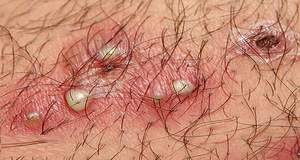Cluster headache overview
Cluster headache is pain that occurs along one side of the head. It’s frequently described as pain that occurs around, behind, or above the eye and along the temple in cyclic patterns or clusters. The pain of a cluster headache is very severe. Many patients describe a “drilling” type of sensation. For classification as a true cluster headache, associated autonomic features such as tearing/watering of the eye, redness of the conjunctiva, rhinorrhea or nasal stuffiness, eyelid drooping, sweating on one side of the face, or changes in pupil size (with the pupil on the affected side becoming notably smaller) are usually present. The headache lasts from 15 minutes to a maximum duration of about 3 hours. However, the headache can recur up to eight times daily. Cluster headache was originally described in the 17th century, but it wasn’t until the mid- 20th century that it became known by this name.
Symptoms of Cluster headache
A cluster headache strikes quickly, usually without warning. Common signs and symptoms include:
- Excruciating pain, generally located in or around one eye, but may radiate to other areas of your face, head, neck and shoulders
- One-sided pain
- Restlessness
- Excessive tearing
- Redness in your eye on the affected side
- Stuffy or runny nasal passage in your nostril on the affected side of your face
- Sweaty, pale skin (pallor) on your face
- Swelling around your eye on the affected side of your face
- Drooping eyelid
The pain of a cluster headache is often described as sharp, penetrating or burning. People with this condition say that the pain feels like a hot poker being stuck in the eye or that the eye is being pushed out of its socket.
People with cluster headache appear restless. They may pace or sit through the attack. In contrast to people with migraine, people with cluster headache usually avoid lying down during an attack because this position seems to increase the pain.
Some migraine-like symptoms including nausea, sensitivity to light and sound, and aura may occur with a cluster headache, though usually on one side.
Cluster period characteristics
A cluster period generally lasts from six to 12 weeks. The starting date and the duration of each cluster period may be consistent from period to period. For example, cluster periods may occur seasonally, such as every spring or every fall.
Most people have episodic cluster headaches. In episodic cluster headaches, the cluster headaches occur for one week to a year, followed by a pain-free remission period that may last as long as 12 months before another cluster headache develops.
Chronic cluster periods may continue for more than a year, or pain-free periods may last less than one month.
During a cluster period:
- Headaches usually occur every day, sometimes several times a day.
- A single attack may last from 15 minutes to three hours.
- The attacks often happen at the same time within each 24-hour day.
- The majority of attacks occur at night, usually one to two hours after you go to bed.
The pain usually ends as suddenly as it begins, with rapidly decreasing intensity. After attacks, most people are completely free from pain, but exhausted.
Who can get cluster headache?
Cluster headache can start at any age but most commonly starts in your 20’s or older. You are not likely to grow out of cluster headache, although as you get older it is likely that the pain free periods between bouts of cluster headache will get longer.
Approximately 1 in 20 people with cluster headache have a family member who also has the condition. Unlike migraine, it is more common in men than women (by five to six times). It is also more common in heavy smokers.
As with all forms of headache, cluster headache occurs in children but it is less common than in adults.
What Causes Cluster Headache?
The cause of cluster headaches is unknown. However, the headaches occur when a nerve pathway in the base of the brain (the trigeminal-autonomic reflex pathway) is activated. The trigeminal nerve is the main nerve of the face responsible for sensations (such as heat or pain.)
When activated, the trigeminal nerve causes the eye pain associated with cluster headaches. The trigeminal nerve also stimulates another group of nerves that causes the eye tearing and redness, nasal congestion, and discharge associated with cluster attacks.
The activation of the trigeminal nerve appears to come from a deeper part of the brain called the hypothalamus. The hypothalamus is home to our “internal biologic clock,” which regulates our sleep and wake cycles on a 24-hour schedule. Recent imaging studies have shown activation or stimulation of the hypothalamus during a cluster attack.
Cluster headaches are not caused by an underlying brain condition such as a tumor or aneurysm.
Self-Care at Home for Cluster Headache
You can treat cluster headache at home under a doctor’s care. Treatment involves 2 types of care, and many people require both at the same time:
- Preventive treatment: This includes ongoing use of medications proven effective in holding off headaches or limiting their number, even when you are not experiencing headaches. Examples are drugs like beta-blockers (propranolol [Inderal], atenolol [Tenormin]), anticonvulsants (topiramate [Topamax], divalproex [Depakote], carbamazepine [Tegretol]), tricyclic antidepressants (amitriptyline [Elavil], nortriptyline [Aventyl]), and calcium channel blockers (verapamil [Covera]). Though widely used, the selective serotonin reuptake inhibitor (SSRI) class of antidepressant (fluoxetine [Prozac], paroxetine [Paxil], escitalopram [Lexapro]) is relatively ineffective for headache.
- Abortive treatment: This is designed to stop a headache once it has begun. Medications include ergotamine (Bellamine, Cafergot), acetaminophen-isometheptene-dichloralphenazone (Midrin), dihydroergotamine (D.H.E. 45 Injection, Migranal Nasal Spray), and more recently, the drugs of the triptan family (almotriptan [Axert], eletriptan [Relpax], frovatriptan [Frova], naratriptan [Amerge], rizatriptan [Maxalt], sumatriptan [Imitrex], zolmitriptan [Zomig]).
In addition, many medications used to treat migraine headache (Excedrin Migraine Pain Reliever/Pain Reliever Aid, oxygen, prednisone [Deltasone]) can also be used for cluster headache.
Can cluster headaches be prevented?
Once cluster headaches have been accurately diagnosed, long-term treatment can be beneficial to decrease or prevent future cycles. However, as the specific underlying cause isn’t known, it may take some time to control the headache cycles.
Risk factors for cluster headaches
Risk factors for cluster headaches include:
- Sex. Men are more likely to have cluster headaches.
- Age. Most people with cluster headaches first develop the disorder between ages 20 and 50, although the condition can develop at any age.
- Smoking. Many people who get cluster headache attacks are smokers.
- Alcohol use. Alcohol can trigger an attack if you’re at risk of cluster headache.
- A family history. If a parent or sibling has ever had a cluster headache, you may have an increased risk of cluster headaches.


















